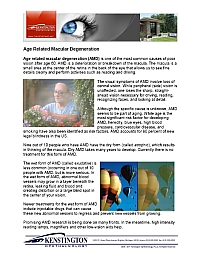 Age Related Macular Degeneration
Age Related Macular Degeneration
Age Related Macular DegenerationAge related macular degeneration (AMD) is one of the most common causes of poor vision after age 60. AMD is a deterioration or breakdown of the macula. The macula is a small area at the center of the retina in the back of the eye that allows us to see fine details clearly and perform activities such as reading and driving.
The visual symptoms of AMD involve loss of central vision. While peripheral (side) vision is unaffected, one loses the sharp, straight-ahead vision necessary for driving, reading, recognizing faces, and looking at detail.
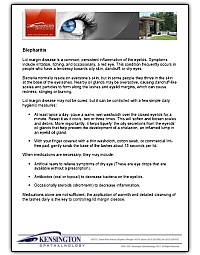 Blepharitis
Blepharitis
Blepharitis – persistent eyelid inflammationLid margin disease is a common, persistent inflammation of the eyelids. Symptoms include irritation, itching, and occasionally, a red eye. This condition frequently occurs in people who have a tendency towards oily skin, dandruff, or dry eyes.
Bacteria normally reside on everyone’s skin, but in some people they thrive in the skin at the base of the eyelashes. Nearby oil glands may be overactive, causing dandruff-like scales and particles to form along the lashes and eyelid margins, which can cause redness, stinging or burning.
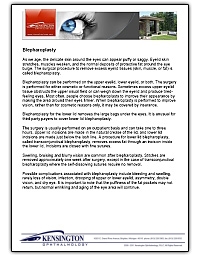 Blepharoplasty
Blepharoplasty
BlepharoplastyAs we age, the delicate skin around the eyes can appear puffy or saggy. Eyelid skin stretches, muscles weaken, and the normal deposits of protective fat around the eye bulge. The surgical procedure to remove excess eyelid tissues (skin, muscle, or fat) is called blepharoplasty.
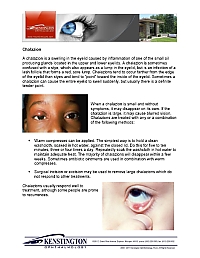 Chalazion
Chalazion
Chalazions – swelling in the eyelidA chalazion is a swelling in the eyelid caused by inflammation of one of the small oil producing glands located in the upper and lower eyelids. A chalazion is sometimes confused with a stye, which also appears as a lump in the eyelid, but is an infection of a lash follicle that forms a red, sore lump. Chalazions tend to occur farther from the edge of the eyelid than styes and tend to “point” toward the inside of the eyelid. Sometimes a chalazion can cause the entire eyelid to swell suddenly, but usually there is a definite tender point.
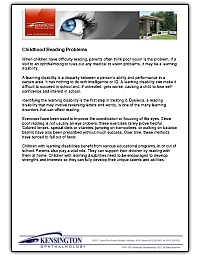 Childhood Reading Problems
Childhood Reading Problems
Children Reading ProblemsWhen children have difficulty reading, parents often think poor vision is the problem. If a visit to an ophthalmologist rules out any medical or vision problems, it may be a learning disability.
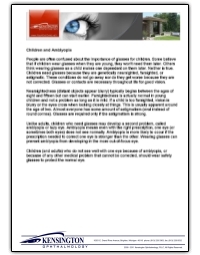 Children and Amblyopia
Children and Amblyopia
Children – AmblyopiaPeople are often confused about the importance of glasses for children. Some believe that if children wear glasses when they are young, they won’t need them later. Others think wearing glasses as a child makes one dependent on them later. Neither is true. Children need glasses because they are genetically nearsighted, farsighted, or astigmatic. These conditions do not go away nor do they get worse because they are not corrected. Glasses or contacts are necessary throughout life for good vision.
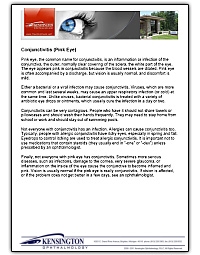 Conjunctivitis (Pink Eye)
Conjunctivitis (Pink Eye)
Conjunctivitis – Pink EyeConjunctivitis (Pink eye), the common name for conjunctivitis, is an inflammation or infection of the conjunctiva, the outer, normally clear covering of the sclera, the white part of the eye. The eye appears pink in conjunctivitis because the blood vessels are dilated. Pink eye is often accompanied by a discharge, but vision is usually normal, and discomfort is mild.
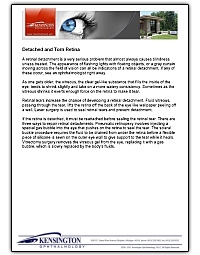 Detached and Torn Retina
Detached and Torn Retina
Detached Torn RetinaA retinal detachment is a very serious problem that almost always causes blindness unless treated. The appearance of flashing lights with floating objects, or a gray curtain moving across the field of vision can all be indications of a retinal detachment. if any of these occur, see an ophthalmologist right away.
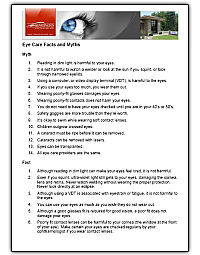 Eye Care Facts and Myths
Eye Care Facts and Myths
Eye Care Facts and MythsFacts and Myths related to your eye care.
 Eyeglasses
Eyeglasses
Prescription Eyeglasses and EyewearSixty percent of the 161 million Americans who wear prescription eyewear choose eyeglasses. Wearing eyeglasses is one of the simplest ways to correct vision problems.
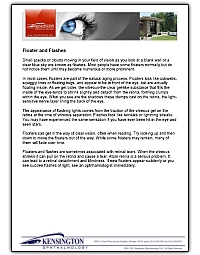 Floater and Flashes
Floater and Flashes
Floater and FlashesSmall specks or clouds moving in your field of vision as you look at a blank wall or a clear blue sky are known as floaters. Most people have some floaters normally but do not notice them until they become numerous or more prominent.
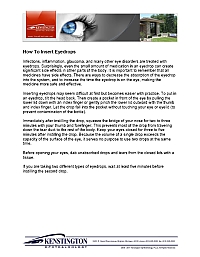 How To Insert Eyedrops
How To Insert Eyedrops
How to insert eyedropsInfections, inflammation, glaucoma, and many other eye disorders are treated with eyedrops. Surprisingly, even the small amount of medication in an eyedrop can create significant side effects in other parts of the body. It is important to remember that all medicines have side effects. There are ways to decrease the absorption of the eyedrop into the system, and to increase the time the eyedrop is on the eye, making the medicine more safe and effective.
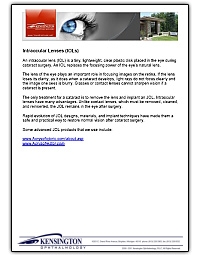 Intraocular Lenses (IOLs)
Intraocular Lenses (IOLs)
How to insert eyedropsAn intraocular lens (IOL) is a tiny, lightweight, clear plastic disk placed in the eye during cataract surgery. An IOL replaces the focusing power of the eye’s natural lens.
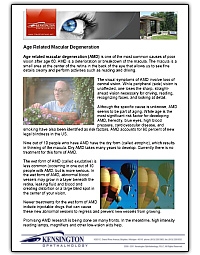 Macular Degeneration and Nutritional Supplements
Macular Degeneration and Nutritional Supplements
Macular Degeneration and NutritionAge-related macular degeneration (AMD) is a disease caused by damage or breakdown of the macida, the small part of the eye’s retina that is responsible for our central vision. This condition affects both distance and close vision and can make some activities-like threading a needle or reading-very difficult or impossible. Macular degeneration is the leading cause of severe vision loss in people over 65.
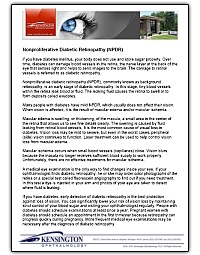 Nonproliferative Diabetic Retinopathy (NPDR)
Nonproliferative Diabetic Retinopathy (NPDR)
Nonproliferactive KeratectomyIf you have diabetes mellitus, your body does not use and store sugar properly. Over time, diabetes can damage blood vessels in the retina, the nerve layer at the back of the eye that senses light and helps to send images to the brain. The damage to retinal vessels is referred to as diabetic retinopathy.
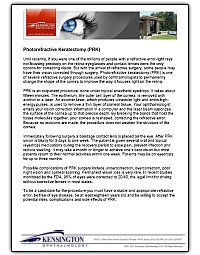 Photorefractive Keratectomy (PRK)
Photorefractive Keratectomy (PRK)
Photorefractive – Keratectomy PRKUntil recently, if you were one of the millions of people with a refractive error-light rays not focusing precisely on the retina-eyeglasses and contact lenses were the only options for correcting vision. But with the arrival of refractive surgery, some people may have their vision corrected through surgery. Photorefractive keratectomy (PRK) is one of several refractive surgery procedures used by ophthalmologists to permanently change the shape of the cornea to improve the way it focuses light on the retina.
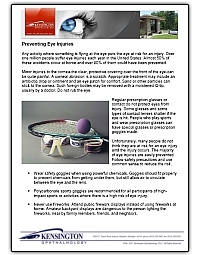 Preventing Eye Injuries
Preventing Eye Injuries
Preventing Eye InjuriesAny activity where something is flying at the eye puts the eye at risk for an injury. Over one million people suffer eye injuries each year in the United States. Almost 50% of these accidents occur at home and over 90% of them could have been prevented.
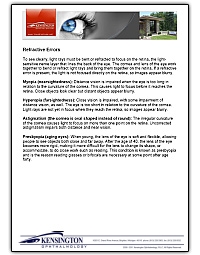 Refractive Errors
Refractive Errors
Refractive ErrorTo see clearly, light rays must be bent or refracted to focus on the retina, the light- sensitive nerve layer that lines the back of the eye. The cornea and lens of the eye work together to bend or refract light rays and bring them together on the retina, If a refractive error is present, the light is not focused directly on the retina, so images appear blurry.
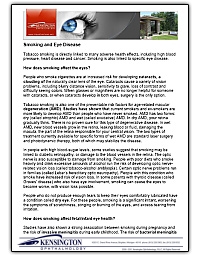 Smoking and Eye Disease
Smoking and Eye Disease
Smoking and Eye DiseaseTobacco smoking is directly linked to many adverse health effects, including high blood pressure, heart disease and cancer. Smoking is also linked to specific eye disease.
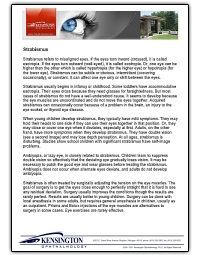 Strabismus
Strabismus
Strabismus – Misaligned EyesStrabismus refers to misaligned eyes. If the eyes turn inward (crossed), it is called esotropia. If the eyes turn outward (wall-eyed), it is called exotropia. Or, one eye can be higher than the other which is called hypertropia (for the higher eye) or hypotropia (for the lower eye). Strabismus can be subtle or obvious, intermittent (occurring occasionally), or constant. It can affect one eye only or shift between the eyes.
